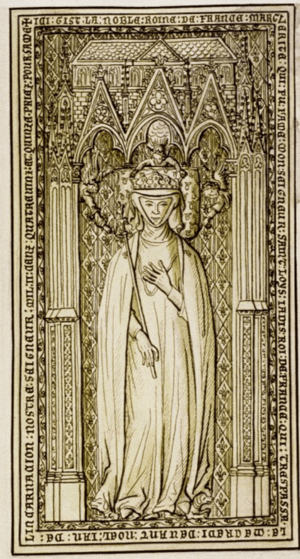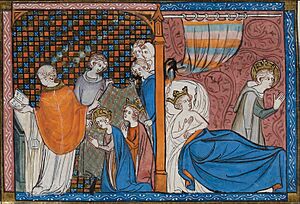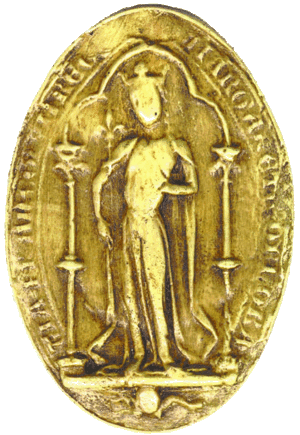Margaret of Provence facts for kids
Quick facts for kids Margaret of Provence |
|
|---|---|

Illustration of the tomb of Queen Margaret, formerly in the Abbey of St. Denis
|
|
| Queen consort of France | |
| Tenure | 27 May 1234 – 25 August 1270 |
| Coronation | 28 May 1234 |
| Born | Spring 1221 Forcalquier, Alpes-de-Haute-Provence |
| Died | 20 December 1295 (aged 74) Paris, France |
| Burial | Saint Denis Basilica |
| Spouse | Louis IX, King of France |
| Issue among others... |
|
| House | Barcelona |
| Father | Ramon Berenguer IV, Count of Provence |
| Mother | Beatrice of Savoy |
| Religion | Roman Catholicism |
Margaret of Provence (French: Marguerite; 1221 – 20 December 1295) was a powerful and influential Queen of France. She became queen by marrying King Louis IX. Margaret was known for her intelligence and bravery, especially during the Crusades. She also played a role in French politics.
Contents
Early Life of Margaret
Margaret was born in the spring of 1221 in Forcalquier, a town in France. She was the oldest of four daughters. Her father was Ramon Berenguer IV, Count of Provence. Her mother was Beatrice of Savoy.
Margaret's younger sisters also became queens. They were Queen Eleanor of England, Queen Sanchia of Germany, and Queen Beatrice of Sicily. Margaret and Eleanor were very close in age. They remained good friends throughout their lives.
Becoming Queen of France
In 1233, Blanche of Castile, the mother of King Louis IX of France, looked for a wife for her son. She heard about Margaret's grace and beauty. Blanche sent a knight to Provence to meet Margaret.
Margaret and her father welcomed the knight. Soon, Blanche began talks with Margaret's father about the marriage. Margaret was chosen because she was very religious and had good manners. She was not just chosen for her beauty.
Margaret traveled to Lyon with her parents. There, the marriage agreement was signed. Her uncles, William and Thomas of Savoy, then took her to her wedding.
On May 27, 1234, Margaret married King Louis IX. She was only thirteen years old. The next day, she was crowned queen of France. Both the wedding and the coronation took place at the cathedral in Sens.
Challenges as Queen
Margaret's marriage was not always easy. Queen Blanche, Louis's mother, had a lot of power. She kept this power throughout her life. Soon after the wedding, Blanche showed her authority. She sent away all of Margaret's servants and uncles. Margaret and Blanche did not get along well.
Margaret was known for her beauty, like her sisters. People said she was "pretty with dark hair and fine eyes." In the early years, Margaret and Louis had a loving relationship. Margaret's confessor, William de St. Pathus, shared stories about them. He said Margaret would put a robe around Louis's shoulders on cold nights. This was when Louis, who was very religious, woke up to pray.
Another story tells that Margaret thought Louis's plain clothes were not fitting for a king. Louis replied that he would dress as she wished if she dressed as he wished. They enjoyed riding horses, reading, and listening to music together. However, Blanche became jealous of their closeness. She tried to keep them apart as much as possible.
Leading During the Seventh Crusade
Margaret went with Louis on the Seventh Crusade. This was their first crusade together. Her sister Beatrice also joined them. The crusade started well, capturing Damietta in 1249. But it later became a disaster. The king's brother was killed, and King Louis was captured.
Queen Margaret then took charge. She was responsible for talking to the enemy and gathering money for Louis's ransom. For a short time, she was the only woman ever to lead a crusade. In 1250, while in Damietta, she gave birth to her son, John Tristan. She also managed to keep order in the city.
The writer Jean de Joinville wrote about Margaret's bravery. For example, she made sure there was enough food for the Christians in Damietta. She even asked the knight guarding her room to kill her and her baby if the city fell to the Arabs. She also convinced some people who wanted to leave to stay and defend Damietta.
Joinville also shared stories showing Margaret's good humor. Once, he sent her some fine cloth. When the queen saw his messenger, she mistakenly knelt down. She thought he was bringing holy relics. When she realized her mistake, she laughed. She told the messenger, "Tell your master evil days await him, for he has made me kneel to his camelines!"
However, Joinville also noted that Louis rarely asked about his wife and children. During a dangerous storm at sea, Margaret begged Joinville for help. He told her to pray and promise to go on a pilgrimage if they survived. She was to offer a golden ship with images of her family. Margaret said she could not make such a promise without the king's permission. She feared he would never let her go. Joinville then promised to make the pilgrimage for her, and he did.
Political Influence
Margaret's leadership during the crusade made her famous internationally. After returning to France, people often asked her to help settle disagreements. She was worried about her brother-in-law Charles. So, she strengthened her bond with her sister Eleanor and Eleanor's husband, King Henry III of England. This was to balance Charles's power. In 1254, Margaret and Louis invited them to spend Christmas in Paris.
In 1259, the Treaty of Paris was signed. This happened after Louis and Henry's relationship improved. Margaret was there during the talks, along with all her sisters and her mother.
In her later years, Louis became annoyed with Margaret's ambition. She was ambitious in politics, but sometimes not very skilled. An English messenger in Paris in the 1250s said Margaret was "tedious in word and deed." He was not impressed with her attempts to get involved in state affairs.
After her oldest son Louis died in 1260, Margaret tried to gain more power. She made her next son, Philip, promise that he would stay under her guidance until he was thirty. This was even if he became king earlier. When Louis found out, he immediately asked the pope to free Philip from this promise. The pope agreed. This ended Margaret's attempt to become as powerful as Blanche of Castile. Margaret also failed to influence her nephew, King Edward I of England. She wanted him to avoid a marriage that would help her brother-in-law, Charles of Anjou, in Provence.
Later Life and Legacy
After King Louis IX died on his second crusade in 1270, Margaret stayed in France. She then returned to Provence. She became more active in politics after his death. She strongly defended her rights in Provence. Charles, her brother-in-law, had kept control of property there. This was against the wishes of Margaret and Beatrice's father, who had died in 1245.
Margaret was very devoted to her sister Eleanor. They stayed in touch until Eleanor's death in 1291. Margaret spent her last years doing good deeds. She founded a Franciscan nunnery called Lourcines in 1289.
Margaret died in Paris on December 20, 1295. She was seventy-four years old. She died at the Poor Clares monastery she had founded. She was buried near her husband in the Basilica of St-Denis outside Paris. Her grave was under the altar steps and was never marked. Its exact location is unknown. Because of this, it was the only royal grave in the basilica not robbed during the French Revolution. It likely remains untouched today.
Children of Margaret and Louis
King Louis IX of France and Margaret of Provence had eleven children:
- Blanche (1240 – 29 April 1243)
- Isabella (2 March 1241 – 28 January 1271), who married Theobald II of Navarre
- Louis (25 February 1244 – January 1260)
- Philip III of France (1 May 1245 – 5 October 1285), who became King of France. He had children, including Philip IV of France.
- John (born and died in 1248)
- John Tristan (1250 – 3 August 1270), born in Egypt during his father's first Crusade. He died in Tunisia during his father's second Crusade.
- Peter (1251–1284)
- Blanche (1253–1323), who married Ferdinand de la Cerda, Infante of Castile
- Margaret (1254–1271), who married John I, Duke of Brabant
- Robert, Count of Clermont (1256 – 7 February 1317). The Bourbon kings of France are descended from him.
- Agnes (c. 1260 – 19 December 1327), who married Robert II, Duke of Burgundy
Images for kids
See also
 In Spanish: Margarita de Provenza para niños
In Spanish: Margarita de Provenza para niños
|
Margaret of Provence
Cadet branch of the Bellonids
Born: Spring 1221 Died: 21 December 1295 |
||
| French royalty | ||
|---|---|---|
| Vacant
Title next held by
Blanche of Castile |
Queen consort of France 1234–1270 |
Succeeded by Isabella of Aragon |




